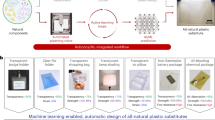Abstract
BEFORE the development of the blast furnace, iron smelting was achieved by ore reduction at temperatures below the melting point of the metal, forming an agglomerated 'bloom' of low-carbon iron and slag. The forced-draught (bellows-operated) shaft furnace known from archaeological studies is usually regarded as the pinnacle of this early smelting technology1–3. Examples of natural-draught furnaces, in which gas buoyancy in a shaft of sufficient height induces a draught adequate to drive the smelting process4, are also known, but are generally regarded as disappointingly inefficient by comparison5. Here I report the discovery and excavation at Samanalawewa, Sri Lanka, of a previously unknown furnace type. The furnaces are all situated on the western margins of hills and ridges, where they are exposed to the strong monsoon winds. Field trials using replica furnaces confirm that this furnace type uses a wind-based air-supply principle that is distinct from either forced or natural draught, and show also that it is capable of producing high-carbon steel. This technology sustained a major industry in this area during the first millennium AD, and may have contributed to South Asia's early pre-eminence in steel production.
This is a preview of subscription content, access via your institution
Access options
Subscribe to this journal
Receive 51 print issues and online access
$199.00 per year
only $3.90 per issue
Buy this article
- Purchase on Springer Link
- Instant access to full article PDF
Prices may be subject to local taxes which are calculated during checkout
Similar content being viewed by others
References
Tylecote, R. F. A Histoiy of Metallurgy 2nd edn (The Institute of Materials, London, 1992).
Rostoker, W. & Bronson, B. Pre-industrial iron (Archeomaterials Monogr. 1, Philadelphia, 1990).
Bamberger, M. in Furnaces and Smelting Technology in Antiquity (eds Craddock, P. T. & Hughes, M. J.) 151–158 (British Museum, London, 1985).
Rehder, J. E. Archeomaterials 2, 47–58 (1987).
Killick, D. in Recent Trends in Archaeometallurgical Research (ed. Glumac, P.) 47–54 (Science and Archaeology Vol. 8, Univ. Pennsylvania, Philadelphia, 1991).
Hadfield, R. J. Iron Steel Inst. 85, 134–186 (1912).
Schoff, W. H. J. Am. oriental Soc. 35, 224–239 (1915).
Bronson, B. Archeomaterials 1, 13–51 (1986).
Chakrabarti, D. K. The Early Use of Iron in India (Oxford Univ. Press, Delhi 1992).
Craddock, P. T. Early Metal Mining and Production (Edinburgh Univ. Press, 1995).
Faraday, M. Q. J. Sci. Lit. Arts 7, 319–330 (1819).
Zschokke, B. Rev. Métall. 21, 635–669 (1924).
Maryon, H. Stud. Conserv. 5, 25–37, 52–59 (1960).
Allan, J. W. Persian Metal Technology 700–1300 AD (Ithaca, London, 1979).
Wadsworth, J. & Sherby, O. D. Prog. Mater. Sci. 25, 35–68 (1980).
Domrös, M. The Agroclimate of Ceylon (Franz Steiner, Wiesbaden, 1974).
Cooray, P. G. An Introduction to the Geology of Sri Lanka (National Museums of Sri Lanka, Colombo, 1984).
Herath, J. W. Mineral Resources of Sri Lanka (Geological Survey Dept, Colombo, 1980).
Juleff, G. Ancient Ceylon 9, 75–107 (1990).
Malim, T. J. P., Juleff, G. & Shotliff, A. in South Asian Archaeology 1995 (edsAllchin, F.R. & B.), (Oxford & IBH, New Delhi, in the press).
De Silva, K. M. A History of Sri Lanka (Hurst, California, 1981).
Forenius, S. & Solangarachchi, R. in Further Studies in the Settlement Archaeology of the Sigirya-Dambulla Region (eds Bandaranayake, S. & Mogren, M.) 135–144 (Postgraduate Inst. Archaeology, Colombo, 1995).
Percy, J. Metallurgy, Vol. 2, 271–273 (Murray, London, 1864).
Rostoker, W., Bronson, B. & Dvorak, J. R. Archeomaterials 3, 11–25 (1989).
Avery, D. H., van der Merwe, N. J. & Saitowitz, S. in The Beginnings of the Use of Metals and Alloys (ed. Maddin, R.) 261–282 (MIT Press, Cambridge, MA, 1988).
von Hammer Purgstall, J. J. Asiatique 5, 66–80 (1854).
Cresswell, R. G. J. hist. Metall. Soc. 25, 76–85 (1991).
Kusimba, C. M., Killick, D. & Cresswell, R. G. in Society, Culture and Technology in Africa (ed. Childs, S. T.) (Science and Archaeology Vol. 11, Univ. Pennsylvania, Philadelphia, in the press).
Somasekaram, T. (ed.) National Atlas for Sri Lanka (Survey Dept, Colombo, 1988).
Author information
Authors and Affiliations
Rights and permissions
About this article
Cite this article
Juleff, G. An ancient wind-powered iron smelting technology in Sri Lanka. Nature 379, 60–63 (1996). https://doi.org/10.1038/379060a0
Received:
Accepted:
Issue Date:
DOI: https://doi.org/10.1038/379060a0
This article is cited by
-
Reading the archaeometallurgical findings of Yodhawewa site, Sri Lanka: contextualizing with South Asian metal history
Asian Archaeology (2022)
-
Uncovering the superior corrosion resistance of iron made via ancient Indian iron-making practice
Scientific Reports (2021)
-
In-situ observation of ancient co-fusion steelmaking process based on HT-CLSM
Scientific Reports (2020)
-
Metallurgical Investigation of a Steel Miner’s Chisel From Ponte Val Gabbia III Site
JOM (2015)
Comments
By submitting a comment you agree to abide by our Terms and Community Guidelines. If you find something abusive or that does not comply with our terms or guidelines please flag it as inappropriate.



